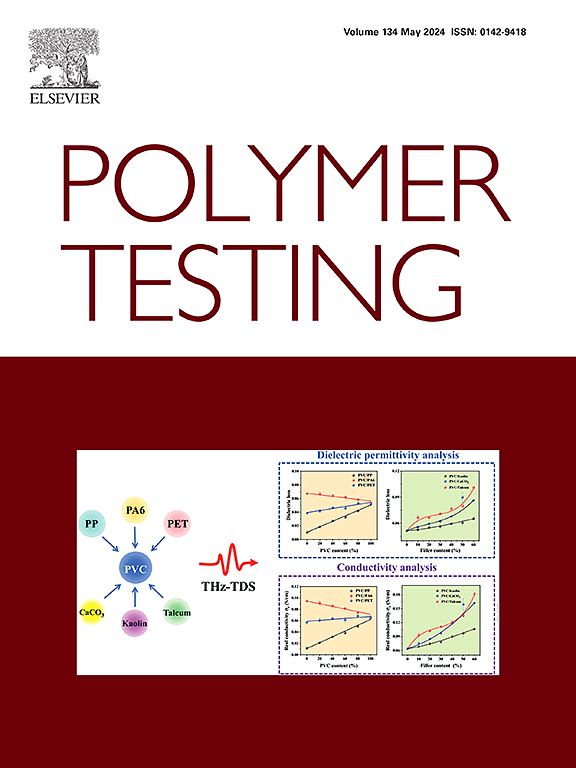Desulfurization of vulcanized rubber by a synergism of chemical and biological treatment, with the strains Gordonia desulfuricans and Rhodococcus erythropolis
IF 5
2区 材料科学
Q1 MATERIALS SCIENCE, CHARACTERIZATION & TESTING
引用次数: 0
Abstract
Developing and improving methods for the management of rubber waste accumulation and its recycling are crucial in addressing environmental problems, and desulfurization is a critical preliminary step before the rubber degradation. This study evaluates the desulfurization of pre- and post-treated vulcanized rubber using a green chemistry method that combines microwave (MW) with hydrogen peroxide and sulfur-oxidizing bacterial strains, Gordonia desulfuricans and Rhodococcus erythropolis. The results indicate that the rubber particles subjected to a synergism of a both treatments were able to continue being desulfurized despite the preliminary treatment. This can be verified in a greater mass loss (14.1 ± 0.8 % using G. desulfuricans, and 11 ± 0.4 % using R. erythropolis, with MW pretreatment) and sulfate release when combining both treatments (14.4 ± 0.7 mg/g using G. desulfuricans, and 22.4 ± 1 mg/g using R. erythropolis, with MW pretreatment). Also, significant changes in C-S and S-O bands, and greater surface fragmentation. A decrease in cross-link density was also observed in cultures with unpretreated rubber and in particles biologically pretreated with subsequent chemical treatment (5.18 × 10−4±3.2 × 10−5 using G. desulfuricans and 5.4 × 10−4±4.5 × 10−5 using R. erythropolis, with MW post-treatment). In addition, the analyses of metals copper, lead, chromium, barium and antimony showed that they were detected in concentrations lower than the maximum limits allowed for effluent discharges to sewage networks, which allows to consider that it consists of an environmentally safe method, reaching values of 1341, 3.6, 3.2, 42, and <1 μg/L, respectively with MW method. Finally, when evaluating desulfurization with biological pretreatment, and subsequent chemical treatment, better results were obtained.

硫化橡胶的脱硫采用化学和生物协同处理,具有脱硫戈登菌和红红红球菌
开发和改进橡胶废弃物的管理和回收方法是解决环境问题的关键,而脱硫是橡胶降解前的关键步骤。本研究采用微波与双氧水、硫氧化菌、脱硫戈登菌和红红红球菌相结合的绿色化学方法,对处理前和处理后硫化橡胶的脱硫效果进行了评价。结果表明,在两种处理的协同作用下,橡胶颗粒在经过初步处理后仍能继续脱硫。这可以通过两种处理联合使用时更大的质量损失(g .脱硫剂为14.1±0.8%,MW预处理时为11±0.4%)和硫酸盐释放(g .脱硫剂为14.4±0.7 mg/g, MW预处理时为22.4±1 mg/g)来验证。C-S和S-O波段变化显著,地表破碎程度增大。在未预处理的橡胶培养物和随后进行化学处理的生物预处理颗粒中,也观察到交联密度的降低(G.脱硫剂为5.18 × 10−4±3.2 × 10−5,红红壤为5.4 × 10−4±4.5 × 10−5,后处理为MW)。此外,对金属铜、铅、铬、钡和锑的分析表明,它们的浓度低于污水管网污水排放允许的最大限值,因此可以认为它是一种环境安全的方法,用MW法分别达到1341、3.6、3.2、42和1 μg/L。最后,对生物预处理和后续化学处理的脱硫效果进行了评价,取得了较好的效果。
本文章由计算机程序翻译,如有差异,请以英文原文为准。
求助全文
约1分钟内获得全文
求助全文
来源期刊

Polymer Testing
工程技术-材料科学:表征与测试
CiteScore
10.70
自引率
5.90%
发文量
328
审稿时长
44 days
期刊介绍:
Polymer Testing focuses on the testing, analysis and characterization of polymer materials, including both synthetic and natural or biobased polymers. Novel testing methods and the testing of novel polymeric materials in bulk, solution and dispersion is covered. In addition, we welcome the submission of the testing of polymeric materials for a wide range of applications and industrial products as well as nanoscale characterization.
The scope includes but is not limited to the following main topics:
Novel testing methods and Chemical analysis
• mechanical, thermal, electrical, chemical, imaging, spectroscopy, scattering and rheology
Physical properties and behaviour of novel polymer systems
• nanoscale properties, morphology, transport properties
Degradation and recycling of polymeric materials when combined with novel testing or characterization methods
• degradation, biodegradation, ageing and fire retardancy
Modelling and Simulation work will be only considered when it is linked to new or previously published experimental results.
 求助内容:
求助内容: 应助结果提醒方式:
应助结果提醒方式:


